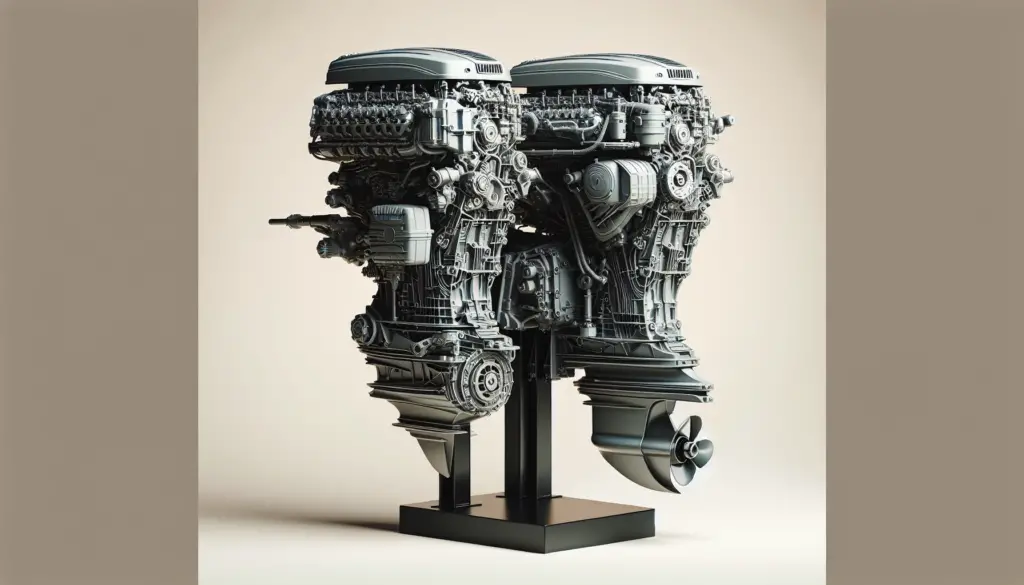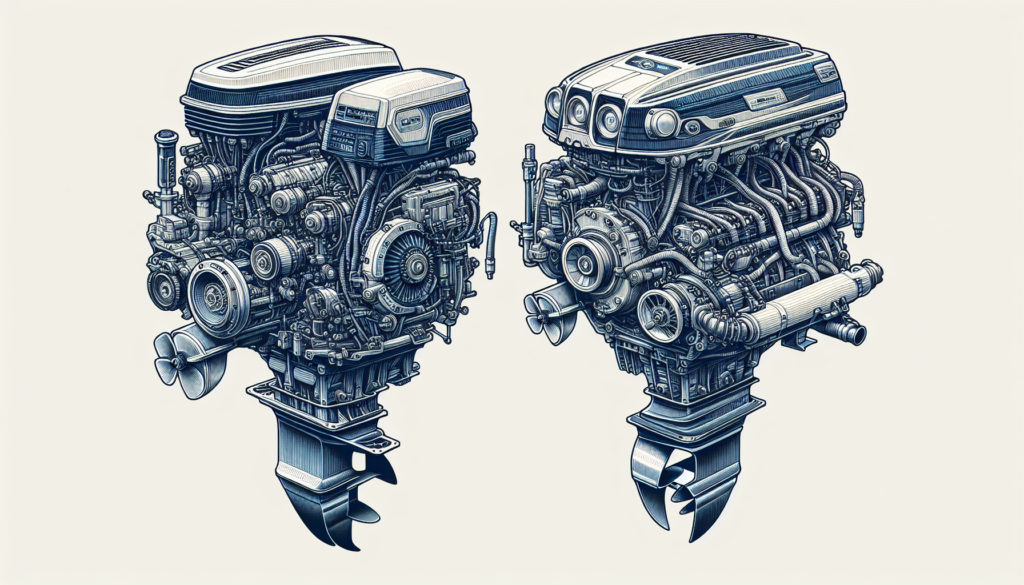Ready to purchase a boat but confused about whether to opt for an outboard or inboard engine? You’re not alone. This guide is crafted just for you, helping to steer your decision-making process. It provides a nuanced comparison between outboard and inboard boat engines, exploring crucial factors such as performance, maintenance, fuel efficiency, and more. By the end of this guide, you’ll have all the information you need to make a confident choice about the engine that’s best suited for your boating needs.
Understanding Outboard and Inboard Engines
When you’re planning to buy a boat, one of the most crucial decisions you need to make is whether to choose an outboard or inboard engine. Differentiating between the two and figuring out which one best suits your specific needs requires understanding their respective definitions, designs, installations, performance, and much more. Let’s dive in!
Definition of Outboard Engine
An outboard engine is a comprehensive propulsion system designed for boats. It’s a portable unit that combines an engine, propeller, and a gear box bundled into a single unit. Its positioning is what gives the engine its name; it’s placed outside the boat, typically on its stern. You’ll find that these engines are versatile in that they are suitable for boats of varying sizes, from small fishing boats to larger sporting vessels.
Definition of Inboard Engine
Comparatively, an inboard engine is placed within the hull of the boat. The propulsion is either direct from the engine, or provided by a jet drive. This type of engine is usually found on larger boats where there’s more space for the engine inside the hull. Their built-in design often results in a smoother, quieter ride, and they tend to be more powerful than their outboard counterparts.
Design and Installation
Outboard Engine Design
Outboard engines are designed to be compact and lightweight, which allows for versatility and portability. They possess a self-contained design housing all essential components within a single unit. This doesn’t just streamline the engine itself, but also allows for easier access during repair and maintenance.
Inboard Engine Design
On the contrary, inboard engines have a split setup, wherein the engine and the propulsion unit are separate entities. The engine is located inside the hull towards the center of the boat, while the propulsion unit (drive shaft and propellers) is at the rear. This arrangement aids in the balance and stability of larger boats.
Installation Process for Outboard Engines
Portability is one of the greatest advantages of outboard engines. Their installation is relatively straightforward, as they easily clamp onto the transom (the back part) of the boat. Some additional wiring is necessary, but the key steps involve aligning the engine with the vessel’s center line and securing it with clamps.
Installation Process for Inboard Engines
Installing an inboard engine is considerably more complex, owing to its split setup. The process involves carefully aligning the engine inside the hull, connecting it to the drive shaft and propeller system. It needs more precision and usually the work of a professional installer to ensure it’s executed accurately and safely.

Performance and Efficiency
Speed and Power of Outboard Engines
Outboard engines are known for being highly efficient and reliable in terms of speed and power. Modern outboard engines can deliver high levels of horsepower, making them ideal for a variety of water activities like water skiing or power boating.
Speed and Power of Inboard Engines
Inboard engines are traditionally associated with more power and are practically built for speed. Their design and larger size often translate into higher horsepower. This is particularly beneficial for towing, cruising at higher speeds or maneuvering larger boats.
Fuel Efficiency of Outboard Engines
Over the years, the fuel efficiency of outboard engines has significantly improved. Modern models now offer greater power output while consuming less fuel, thus reducing operating costs.
Fuel Efficiency of Inboard Engines
Inboard engines might have an edge in terms of raw power, but they generally consume more fuel than their outboard counterparts. However, their improved fuel burn rate and larger fuel tanks mean you may enjoy longer trips without refueling.
Maintenance and Repair
Maintenance Requirements of Outboard Engines
The maintenance requirements of outboard engines are generally lower. Most outboards are designed for easy access to all moving parts, making regular upkeep and troubleshooting a simpler process overall.
Maintenance Requirements of Inboard Engines
Maintenance of inboard engines can be more labor-intensive due to their location inside the hull. Regular maintenance includes oil changes, belt checks, and checks on the cooling and exhaust systems.
Ease of Repair for Outboard Engines
The compact and accessible design of outboard engines makes them relatively easy to repair. In many cases, the entire unit can be replaced quickly if needed, reducing downtime.
Ease of Repair for Inboard Engines
As with their maintenance, repairing an inboard engine can be more challenging due to its positioning within the boat. However, they’re typically designed to be more reliable and durable, requiring fewer repairs over time.

Costs and Budget
Pricing of Outboard Engines
The initial cost of outboard engines tends to be lower and the maintenance costs are also generally less expensive due to their design and ease of access.
Pricing of Inboard Engines
Inboard engines usually command a higher price tag because of their higher power and larger size. Plus, with more complex installation and higher maintenance costs, they might not be the most budget-friendly option.
Costs of Maintenance and Repairs
As touched upon earlier, the costs of maintenance and repairs can be higher for inboard engines. This is because of their complexity and the need for regular professional maintenance.
Noise and Vibration Levels
Noise levels in Outboard Engines
Outboard engines are generally louder due to their external placement. However, advancements in technology have led to quieter designs, which could help reduce noise levels significantly.
Noise levels in Inboard Engines
Due to their internal placement within the hull of the boat, inboard engines usually generate less noise and vibrations, providing a smoother and quieter boating experience.
Vibration in Outboard Engines
Vibration levels in outboard engines can be higher compared to inboard engines because of their outside positioning and direct contact with water.
Vibration in Inboard Engines
Inboard engines, placed inside the hull, produce lower levels of vibration, ensuring a smoother ride.
Safety Considerations
Safety Features of Outboard Engines
Outboard engines come equipped with certain safety features such as emergency shut-offs and theft-deterrent systems. In the event of an accident, it’s easier to cut off fuel supply as the entire engine unit is accessible. This reduces the risk of fire.
Safety Features of Inboard Engines
Inboard engines are considered quite safe as they are located within the boat, providing a lower center of gravity and thus more stability. However, because the engine isn’t directly accessible, it can be more difficult to cut off the fuel supply in case of an emergency.
Environmental Impact
Emission Levels of Outboard Engines
Emission levels of outboard engines have dramatically improved over the years. With the introduction of cleaner-burning technologies, the newer models are now much less polluting.
Emission Levels of Inboard Engines
Inboard engines traditionally have higher emission levels due to their larger size and fuel burn rate. However, many manufacturers are working towards lower emission models to reduce environmental impact.
Lifespan and Durability
Lifespan of Outboard Engines
Outboard engines, when maintained properly, can enjoy a long lifespan. Their ease of maintenance contributes to their longevity and durability.
Lifespan of Inboard Engines
Quality inboard engines can be expected to last for many years. Their enclosed placement inside the hull often shields them from external elements, increasing their lifespan.
Durability of Outboard Engines
Outboard engines are durable and adaptable to different types of water conditions. However, their external placement can also expose them to elements that may affect their longevity.
Durability of Inboard Engines
Inboard engines, thanks to their positioning within the hull, are generally more protected and therefore often exhibit higher durability than outboard engines.
Resale Value and Market Trends
Resale Value of Boats with Outboard Engines
Boats with outboard engines generally have good resale value, especially if the engines have been properly maintained. Their flexibility and popularity contribute greatly to this factor.
Resale Value of Boats with Inboard Engines
Boats with inboard engines can also demand high resale values, especially those with low hours and regular maintenance records. These engines’ power and performance characteristics make them attractive to many boaters.
Current Market Trends
In recent years, there has been a significant rise in the demand for outboard power, driven by improvements in technology and the engines becoming quieter, lighter and more efficient. However, inboard engines have always retained a steady market, particularly among enthusiasts of water sports and owners of larger boats.
In conclusion, there is no ‘best’ choice between inboard and outboard engines. It all depends on your preferences, budget, and boating requirements. It’s always best to weigh all factors carefully before making a decision. Happy boating!

